Table of Contents
What Religions Use Psychoactive Drugs?
Religions and Drugs: the Use of Psychoactive Drugs in Rituals

The world is a really big place, and as similar as each human being is in a biological sense to itself as a species, there are very many belief systems throughout the planet. Just as many belief systems as there may be, there are diversities in cultural development as a whole. In other words, some cultures around the world still operate as though they are in ancient times, while other cultures have massively surpassed them in all types of advancement. The more indigenous the tribe, the more primitive the rituals and religious ceremonies. Some of these religions and rituals can be barbaric, others simply eccentric or of an abstract nature. And some of these ceremonies are extremely profound, both spiritually and chemically speaking.
Indians of Peru
The Native Peruvians used Angel’s Trumpet (Brugmansia arborea) for religious ceremonies that allowed them to communicate with their ancestors. Shaman also used Paguando in divination for its hallucinogenic properties. Teonanacatl is a sacred mushroom used in a number of rituals.
Tukanoan Yurupari
The Tukanoan Yurupari ceremony in Colombia is sort of like an Jewish bar mitzvah. This ceremony employed Yaje, or Ayahuasca.
Jivaro People
The Jivaro Natives used Ayahuasca in many ceremonies to communicate with ancestors and “spirit walk,” a form of astral projection, where one sees oneself outside of their own body. They also employ Chiricaspi as a magico-religious hallucinogen.
Aztecs, Mazatec, and Zapotec
The Indians of Mexico often used the Piule plant for divination and other magico-religious purposes. It has a well-respected place in many religious rituals throughout Mexico. El Nene was also an important magico-religious plant which was employed for divination. Salvia divinorum has been used as a powerful shamanic hallucinogen for visions, divination and vivid dreams. They also held the plant Kieli sacred for its ability to aide sorcery. Ololiuqui is one of the most sacred plants of all tribes of Ancient Southern Mexican Indians, and makes its way into a number of their ceremonies. The Conocybe mushroom known as Tamu or Teonanacatl is well-respected and used in many religious ceremonies. Toloache was used by shaman as a sacred hallucinogen.
Tarahumara Indians of Mexico

The Tarahumara were well-known to use many hallucinogens and psychoactive plants throughout a number of their cultural rituals and religious ceremonies. One of them most commonly employed was Bakana, both the cactus and the herb, and both of which were used as sacred hallucinogens. Cawe, among other plants, are also used in the same ways. Peyote, as well as the false peyotes are all well-respected and regarded to have sacred value in Tarahumara culture.
Egyptian Cultures
The Blue Water Lily was used by Egyptians for its significance in shamanic rituals. Nutmeg also seems to have significant religious value in some Egyptian rituals.
Maku Indians of the Rio Tikie
The Maku used Caapi-Pinima for its hallucinogenic properties in their religious rituals.
Tribes of the Orinoco Basin
The South American tribes of Argentina and Peru are well-known to use Cebil as a religious hallucinogen.
Kofan of Colombia and Kasama of Ecuador

Manaka (Brunfelsia chiricaspi) is used in many religious concoctions for its hallucinogenic and shamanic effects. They also employed Shanin (Petunia) and Shanshi (Coriaria thymifolia) for their ability to give shaman the feeling of flight and out-of-body experiences. Taique also makes regular occurrences throughout tribal ceremonial drink preparation.
Native American Tribes
Fly Agaric mushrooms have strong religious significance and are present in a variety of Native American rituals, especially of shamanic nature. Genista (Cytisus canariensis) is also used for a variety of magical and hallucinogenic purposes in several ceremonies. Mescal Beans were commonly used for vision-seeking, divination and ceremonial dancing. Peyote was made legal for use by members of the Native American Church in the United States and Canada, despite being otherwise illegal in the countries.
Bwiti Cult
The Bwiti were known to employ Iboga (Tabernanthe iboga) as a religious tool for communicating with their ancestors, and to seek knowledge from the spirit world. There are a number of religious ceremonies that involve Iboga.
Huichol Indians of Mexico
The Huichol have used many cacti ion their religious rituals. One of the most common is Hikuli Suname (Epithelantha micromeris). They also valued Tagetes, also known as “Yauhtli,” having a place for it in many religious ceremonies that induce and enhance visions.
Hottentots of South Africa

The Hottentots of South Africa chew and smoke the root and leaves of the Kanna plant for its vision-inducing and hallucinogenic effects. Lion’s Tail (aka Wild Dagga) was also used in a similar way.
Pariana Indians of the Brazilian Amazon
The Indians of this region are well-known to have used Maquira, which is also known as Rape dos Indios. The plant makes way into many tribal ceremonies and religious customs.
New Guinea Natives
Many tribes throughout New Guinea have used Screw Pine for its hallucinogenic properties in many shamanic ceremonies.
Religious Rights to Drugs
For as long as plants grow on earth, it could be speculated that there will be psychoactive plants. For as long as human beings walk the globe, it can be speculated that they will consume, cultivate, and otherwise experiment with the plants available throughout the planet. Thus, deduction tells a tale of infinite historical psychoactive plant use among human beings, as well as an infinite future use, so long as humans walk the Earth alongside psychoactive plants. Some religions have even fought to continue to use plants which have been made illegal (or otherwise banned) in their areas of practice.
Human beings have always had a tendency to explain the unknown in whatever way they can make sense of. Religion is able to cross boundaries that science cannot cross, thus being able to more appropriately explain the psychedelic effects and psychoactive properties of plants. This rule is especially true in ancient and older times, however even with the understanding of chemical constituents within a psychoactive plant, there is still so much which cannot be explained by science.




